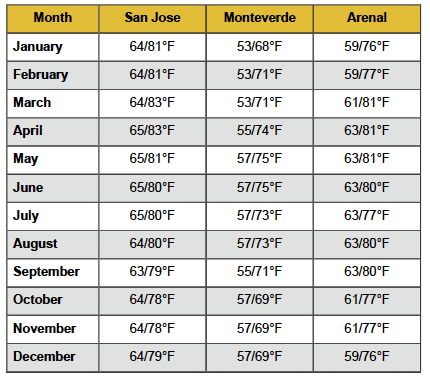COSTA RICA

Fun Facts From Globus Tours
-
-
- Costa Rica covers an area of 19,730 square miles
- Costa Rica has a life expectancy of 77 years, one of the highest in the world
- There are more than 121 volcanic formations in Costa Rica of which seven are active. Irazu is the tallest volcano at 11,259 feet
- Costa Rica means “Rich Coast”
-
Of all the Latin American destinations, Costa Rica might be one of the most endearing. It’s such a tiny country, tucked between Nicaragua and Panama, not much larger than the state of West Virginia. But despite its size, it is one of the most exciting places to visit in Latin America. The common expression in Costa Rica is, “Pura Vida!” meaning “pure life” and the locals follow it to the letter. The people of Costa Rica, called Ticos, are famously known as some of the friendliest in the world. They are welcoming of visitors and want to share their traditions, food, land, beaches, and good nature. Costa Rica has a warmth to it, not just in the literal sense as it enjoys exceptional weather all year long due to its location, but a friendly, fun, and welcoming nature – evoking a feeling of home and a chance for relaxation unlike any other spot in Central or South America. The array of flora and fauna, the lively cities, striking beaches, active volcanoes, water sports, canopy tours, national parks, wetlands, the sounds of music and nature – are just some of the reasons to visit Costa Rica!
San José
San José is most likely the first city to host you on your Costa Rican vacation and there are a few things worth seeing aside from strolling the streets and checking out the local culture. This is the place to get in your history lessons, museum time, and people-watching. The Teatro Nacional is the pride of San José. If you have the opportunity to see a performance here, snag it! But if not, just seeing the gorgeous décor is well worth a visit. The Museum of Contemporary Art and the History Museum are the other city-center institutions to see.
Guanacaste
Since the beaches of Costa Rica are one of the greatest draws for visitors, there must be something magical about them. The beaches all along the Pacific Coast are well-known for having some of the best breaking waters for ocean sports, a combination of white and black sand beaches, incomparable sunsets, party atmospheres as well as peaceful wave-lapping seclusions. The Northern Pacific area of Guanacaste is considered the oldest part of Costa Rica and is loaded with local tradition to honor it. Folklore is particularly vivacious here and the locals are known for their friendly nature and eagerness to share their culture. Along with beautiful beaches, nearby you will find Rincon de le Vieja National Park and Palo Verde National Park. These unique areas are teeming with wildlife and offer visitors ample activities like white water rafting, nature hikes, and horseback riding.
Manuel Antonio
A little further south on the Pacific Coast, Manuel Antonio is one of the best beaches to visit. Aside from a soft and welcoming yet energetic beach, it is backed by Manuel Antonio National Park, one of the most radiant natural forests in the country. Mangrove swamps meet with pristine beaches; it possesses all the peace and harmony of the classic seagull sounds and crashing waves synonymous with vacation. If you have the opportunity, take a short hike up to Cathedral Point to see the sunset over the Pacific – it’s one of the most uninterrupted views along the central coast. And if you’ve always wanted to get your picture taken holding a giant, freshly caught fish, the waters of Manuel Antonio lend themselves to some of the best deep-sea fishing in Costa Rica.
Arenal
Costa Rica is dotted with National Parks, all loaded with impressive wildlife and unique flora. It is often referred to as “the last jungle frontier,” as it is home to some of the only remaining species of trees and plants in the world. While some of the best National Parks are associated with Pacific Coast beaches, there are a few others that are must-sees on your vacation. Arenal Volcano and National Park is a tremendous source of pride for Costa Rica. As the volcano has been active for years, it is an intriguing spot to explore – lush forest where you can horseback ride, go spelunking in caves, or walk the suspension bridges in the high tree canopies. Arenal Lake is a sight to behold and humming with activity from mountain biking to horseback riding, to fishing, and kayaking. Of course the amazing backdrop of the volcano makes this lake unique and picturesque. While the volcano in recent years has not displayed much lava flow, it is still alive with steam and helps to produce some of the most exotic and retreat-like hot springs in Central America. No trip to Arenal would be complete without a visit to some of the hot spring complexes that allow you to relax in the healing thermal waters.
Monteverde
While you’re exploring the lake, not far from Arenal National Park, Monteverde awaits in the cloud forest. The greens are so intense here and the wildlife so prevalent, you’ll feel the jungle permeate every second of your day and sooth you to sleep at night. Monteverde and its closest town of Santa Elena are some of the most intimate experiences for authentic culture in Costa Rica. You can even visit local family farms to learn about their ways of life and how they farm tilapia fish, sugarcane, and superb coffee. Northwest you’ll find one of the most adventure-filled National Parks – Rincon de la Vieja. This rainforest is particularly well arranged for canopy tours where you can zipline your way through, hop on a horse, hike to a remote waterfall, or hop into a raft and traverse the rivers.
Tortuguero
Just when you thought that might cover all of the National Parks in Costa Rica…that’s not even the half of them! But for a different take on Costa Rica’s National Parks, Tortuguero is unique as it’s the only park on the Caribbean side of the country. While the east coast gets a little more rain than the Pacific, it provides a less touristy, off-the-beaten-path kind of experience. One of the biggest reasons to travel here are the turtles for which the area is aptly named. In April and May you can see hundreds of turtles, many of them endangered, nesting and laying their eggs. It also has gorgeous, well-protected waterways that are teeming with life – hundreds of various canals crisscrossing all over the park reveal endangered bird species, freshwater turtles, monkeys, and herons. Being one of the safest, most accessible, and most affordable destinations in Central America, Costa Rica is ideal for the independent traveler, a romantic getaway, or a family vacation. But practicality aside, it’s an absolute blast! In such a small area, you can experience dozens of natural reserves, active volcanoes, lakes, and dense rainforests. On the various beaches – both Pacific and Caribbean – caves, coves, and craggy ocean sides compliment warm, sandy expanses, vibrant sunsets, and blissfully clear and brilliant waters, exploding with life. Once you visit Costa Rica, you’ll have new knowledge of nature, probably some new adventurous skills, and a fresh outlook on life – as the people here, the food, the landscape, and truly paradise-like beaches are unique to the Pura Vida style of Costa Rica.
VISAS, PASSPORTS, AND OTHER ENTRY REQUIREMENTS
A visa for your visit to Costa Rica is not necessary for US citizens. If you hold a passport from another country, check with your local consulate about requirements for travel to Costa Rica.
All passengers traveling internationally are required to have a passport. Most countries require that the passport be valid for at least six (6) months beyond the conclusion of your trip, so please check the expiration date carefully. It is also recommended you have a minimum of three blank pages in your passport when traveling, as many countries require blank pages. Please carry proper identification (your passport) on you and do not leave it in your suitcase or hotel room. Most countries have laws that require you to carry your passport with you at all times..
COUNTRY CODES
The country code for Costa Rica is 506. When calling to Costa Rica from overseas, dial your international access code (011 from the US/Canada), followed by the country code, area code, and phone number. Phone numbers in Costa Rica are 8 digits in length. Dialing from the US/Canada: 011 506#### ####.
CURRENCY
The official currency of Costa Rica is the Costa Rican colón (CRC). 1 Costa Rican Colón (CRC) = 100 centimos
-
-
- Banknote denominations: 1000, 2000, 5000, 10000, 20000, 50000
- Coin denominations (centimo): 5, 10, 50, 100, 500
-
Note: US dollars are often accepted in Costa Rica, though sometimes at a lower exchange rate. Please check before using US dollars.
For the most current exchange rates, please go to our website at Globusjourneys.com/Currency.
Credit cards are accepted in Costa Rica, and you should have no problems using them in larger shops and restaurants. Visa and MasterCard are the most accepted. Smaller shops may ask you to pay in cash or have a minimum amount required to use a credit card. Traveler’s checks are extremely difficult to exchange in Costa Rica. Their use is not recommended.
Bank Hours:
- Mon. – Fri.: 9 am – 4 pm
- Sat. – Sun.: Closed
BUDGETING AND SHOPPING
The following budget guidelines are just approximate values or starting values for meals and are per person. Actual prices will vary widely by restaurant and city within a country but below are some averages as provided by our experienced personnel.
-
-
-
- The approximate cost of a soft drink/mineral water/coffee is US$1.50.
- An average lunch consisting of a salad or sandwich and a soda or water starts at approximately US$7.
- Dinner at a mid-range restaurant with dessert and a non-alcoholic beverage starts at approximately US$33.
-
-
Shopping
In open street markets, try not to touch items unless you are interested in purchasing them. If you would like to take photos, please ask permission. Most vendors are happy to have their picture taken with the item you have just purchased. If you are being confronted by vendors, smile, say nothing and then shake your hand low to say no. This is polite and they understand. For many people, saying “No” means I want it at a lower price and they will follow you in attempt to bargain.
In many areas of Central America, bargaining for purchases is normal. First, ask for a price. Offer an amount slightly below what you wish to pay. It is important to be polite and smile while bargaining. In most cases, bargaining will not save you a lot of money. Keep different value bills folded and separated in different pockets, that way you can pull out the exact money you need, and sometimes this can close the deal. Opening a wallet or purse to pull a roll of bills out can lead to negotiation problems. Always finish the transaction with Thank You and a smile.
TIPPING
In Costa Rica, it is not customary to leave a tip in restaurants. A 10% service charge is already included on top of the 13% sales tax.
Taxis do not expect tips.
Tip hotel staff for room service or bar service (500 colón is an average amount).
ELECTRICITY AND ELECTRICAL OUTLETS
Outlets
Voltage for outlets is 110V. North American voltage is generally 110V. Therefore, you will need a converter for your travels. Adapters will be necessary to adapt your plug into the outlet, but these may not convert the voltage, so both devices are necessary.

TEMPERATURES
Costa Rica’s climate is tropical year round, with plenty of warm weather and rainfall.To help you plan, below are average low and high temperatures for Costa Rica.

To convert to Celsius, subtract 30, then divide by 2. While not exact, this simple formula will give a close estimation.
FOOD SPECIALTIES
Fresh fruit, Casado (rice & beans with chicken or fish), fried plantains, grass-fed meats, Olla de carne (meat & vegetable stew), and gallo pinto (black beans and rice) are all commonly found in Costa Rica. In restaurants, always ask if they have menus in English, as many establishments will.
Drinking Water
Bottled water is how many people drink water even at home. Never ask for tap water for many reasons. Ice is rarely used as well.
CUSTOMS AND CULTURE
Greeting and Interaction
-
-
- The best way to address people when you do not know their name is to simply use “Señor” (male) or “Señora” (female).
- It’s normal to introduce yourself with a polite greeting of “buenos días/tardes” (good morning/ afternoon or evening).
- Greeting customs in Central and South America also incorporate a lot of personal contact. Women will generally greet other women by kissing once on each cheek, right to left. Men will also kiss women on the cheeks when greeting them, but handshaking is reserved for between two men.
- People here have a tendency to stand relatively close to each other when they are talking. Although you might find that this is perhaps a little too close for your liking, you should just accept that this is normal behavior, and trying to create more space between you and your counterpart could be seen as rude.
-
Public Restrooms
Ladies should always travel with tissue. If public restrooms have toilet paper, it is sometimes rationed. Hand sanitizers are recommended to bring with you as some bathrooms may not have hot water and soap. In some public restrooms you are required to pay a small fee.
FEW WORDS OF THE LOCAL LANGUAGE
Spanish: CONVERSATION

¡Hola! Hi!, ¡Buenos Dias! Good morning!, ¡Buenas Noches! Good evening!, Me llamo _______. My name is _______., ¿Cómo se llama usted? What is your name?, Mucho gusto. Pleased to meet you., ¿Cómo está usted? How are you?, Bien, gracias. ¿Y usted? Fine, thanks. And you?, Mas o menos So-so, ¡Hasta luego! See you later!, Adiós. Good-bye., Por favor. Please., Vivo en ________I live in _____________, (Muchas) gracias. (Muy amable.) (Many) thanks. (Very kind.), De nada. You’re welcome., Lo siento. I’m sorry., ¿Me permite? May I?, Disculpe. Excuse me. (To get someone’s attention.), Con permiso. Excuse me. (For leaving or passing through.), Perdón. Excuse me. (For sneezing, arriving late, etc.), ¡Salud! Gesundheit! (When someone sneezes.) Cheers! (For toasting with drinks.), ¿Me pasa _______ por favor? Could you please pass me _______?, Sí. Yes., No. No., Gracias Thank you, No entiendoI don’t understand, No hablo español I don’t speak Spanish,¿Habla inglés? Do you speak English?, ¿Dónde está el baño? Where is the bathroom?, Está cerca? Is it near?, Está lejos? Is it far?, Siga recto. Go straight ahead., Gire a la derecha. Turn right., Gire a la izquierda. Turn left., Nescito esto. I would like this., Una mesa para dos, por favor. A table for two, please., La carta, por favor. The menu, please., La lista de vinos, por favor. The wine list, please., primer plato appetizers, plato principal main course, postre dessert, Quisiera algo para beber. I would like something to drink., Un vaso de agua, por favor. A glass of water, please., Una Cerveza. Beer, Una Copa de vino tinto/blanco Glass of red/white wine, La cuenta, por favor. The check, please., Incluye la propina? Is the tip included?, Desayuno Breakfast., Comida lunch, Cena dinner, ¡Buen provecho! Enjoy the meal!, ¡Salud! To your health!, Está riquísima! It’s delicious!, Plato. plate, Tenedor. fork, Cuchillo. knife, Cuchara. spoon, Servilleta. napkin, Hielo. ice, Sal. salt, Pimiento. pepper, Azúcar. sugar, Sopa. soup, Ensalada. salad, Pan. bread, Mantequilla. butter, Pollo. Chicken, Carne. Beef, Cerdo. Pork, Quisiera la carne poco cocida. I like my steak rare., Quisiera la carne a medio cocer. I like my steak medium., Quisiera la carne bien cocida. I like my steak well done.
NUMBERS
Cero. Zero, Uno. 1, Dos. 2, Tres. 3, Cuatro. 4, Cinco. 5, Seis. 6, Siete. 7, Ocho. 8, Nueve. 9, Diez. 10, Once. 11, Doce. 12, Trece 13, Catorce 14, Quince 15, Dieciseis 16, Diecisiete. 17, Dieciocho. 18, Diecinueve. 19, Veinte. 20, Cien. 100, Mil. 1000.
U.S. DEPARTMENT OF STATE COUNTRY INFORMATION
Additional country-specific information for US citizens can be found on the US Government’s website www.travel.state.gov. Here, you can find the most up-to-date information about destination descriptions, passports/visas, safety and security, transportation, travel local laws, alerts/warnings, vaccinations, and more. For citizens of other nations, we recommend you consult your local consulate for travel information, regulations, and requirements.













